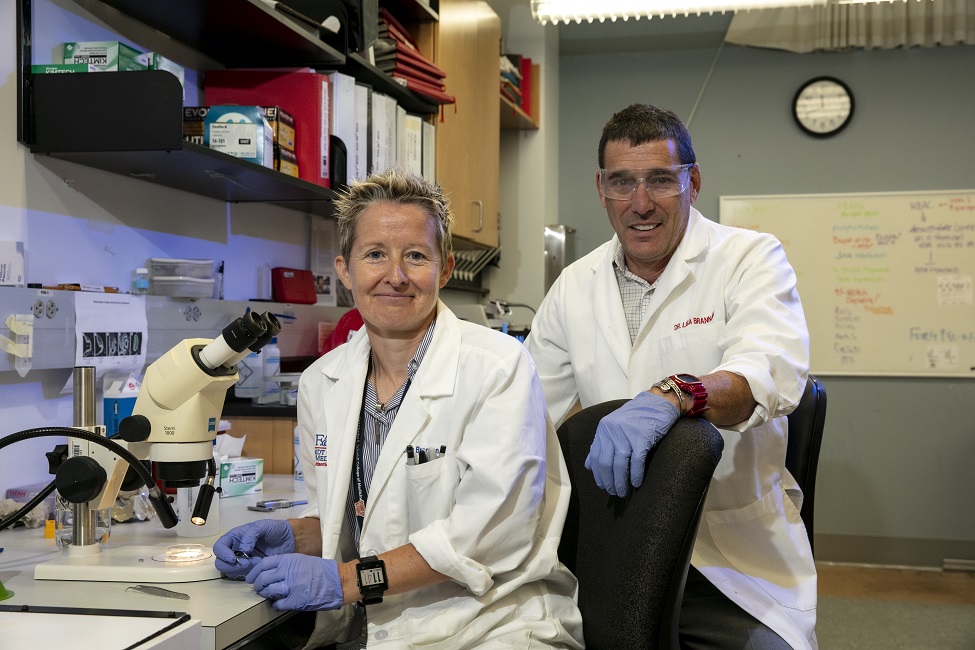FAU Lands $1.9M NIH Grant for Novel Way to Treat Degenerative Disease

(Left) Lisa A. Brennan, Ph.D., research professor; and Marc Kantorow, Ph.D., associate dean of graduate programs and a professor of biomedical science, FAU Schmidt College of Medicine.
Researchers from Florida Atlantic University’s Schmidt College of Medicine have received a five-year, $1.9 million grant from the National Eye Institute of the National Institutes of Health (NIH) for a promising and novel way to treat degenerative diseases by replacing damaged dysfunctional cells with new cells.
New replacement cells can be genetically engineered in the laboratory through programming of embryonic stem cells that can act as universal precursors for formation of mature cells and tissues. Although multiple strategies have been devised to program immature stem cells into functional adult cells, a major stumbling block has been identifying all the requirements for adult cell formation.
With this NIH grant, the research team, led by principal investigator Marc Kantorow, Ph.D., associate dean of graduate programs and a professor of biomedical science; and Lisa A. Brennan, Ph.D., research professor; FAU Schmidt College of Medicine, will determine the novel mechanisms that convert immature eye lens precursor cells into functional transparent cells.
The Kantorow laboratory team, including Josh Disatham, Ph.D., a post-doctoral fellow funded by FAU’s Institute for Human Health and Disease Intervention (I-Health), discovered that low oxygen levels (hypoxia) are a key driver of the cellular reprogramming events leading to formation of mature transparent lens cells. This new grant seeks to identify the pathways controlling this hypoxia-induced cellular transformation event.
“This research led by the Kantorow laboratory is a game-changer for the future of regenerative medicine,” said Lewis S. Nelson, M.D., dean and chief of health affairs, FAU Schmidt College of Medicine. “By uncovering the precise requirements for transforming stem cells into fully functional adult cells, we are addressing one of the most critical challenges in treating degenerative diseases. This breakthrough has the potential to dramatically improve patient outcomes by offering new hope for restoring damaged tissues and organs, ultimately enhancing both the quality and longevity of life.”
Regenerative therapies for degenerative diseases rely on understanding how immature cells develop into their mature forms.
“Specifically, our work will examine the role played by the master regulator of the hypoxic response, hypoxia-inducible transcription factor 1 or HIF1a in control of lens gene expression and the requirement for oxygen-induced epigenetic modifications that regulate DNA conformation,” said Kantorow. “These novel studies, using lens cells as a model system, provide clues into the development of strategies for engineering of more complex cells and tissues and therefore novel therapies for the treatment of degenerative disease.”
In the case of the eye’s lens, the process of how immature cells develop into their mature forms involves a single layer of epithelial cells on the surface transitioning into fiber cells in the core. For fiber cells to mature and make the lens clear, they must activate specific genes responsible for structural proteins such as crystallins, metabolic changes (switching to glycolysis), and the removal of internal organelles. If this process fails, it can lead to cataracts, a major cause of vision problems.
“While signaling molecules like fibroblast growth factors are known to start this transformation, we still don’t fully understand how critical genes for fiber cell maturation are regulated,” said Brennan. “Our latest research aims to explore how hypoxic conditions in the lens core help drive gene activation through unique transcriptional and epigenetic mechanisms, filling a key gap in our knowledge about lens development.”
The Kantorow laboratory focuses on understanding the molecular and mitochondrial mechanisms that drive ocular development and disease. Specifically, the lab uses the eye lens and retina as model systems to explore cellular differentiation, function and disease processes. The research spans from analyzing the roles of genes implicated in ocular diseases to studying the direct effects of environmental factors like UV light and other agents on mitochondrial and cellular functions. Additionally, the lab examines how key cellular systems can be manipulated to prevent or treat ocular conditions, including age-related cataract formation and macular degenerations, which are leading causes of visual impairment worldwide.
A key focus of the Kantorow laboratory is uncovering the biological programs that guide immature cells during embryogenesis and throughout life to develop and maintain functional tissues. The ultimate goal is to use insights from these studies to engineer cell systems and transplantable cells capable of restoring the functions of damaged tissues and organs. To achieve this, researchers employ a wide range of advanced techniques, including human genetic analysis, protein biochemistry, molecular and cell biology, confocal and electron microscopy, transgenic and knockout animal models (mouse and chick), bioinformatics, computational biology, and global expression and gene modification analysis.
“Hypoxia activates key transcription factors and induces chromatin changes, regulating a wide array of cellular processes, including autophagy and cellular remodeling,” said Kantorow. “Findings from our studies not only illuminate fundamental biological mechanisms of cellular differentiation but also provide a foundation for developing regenerative therapies and other treatments for age-related and degenerative diseases.”
The Kantorow laboratory has been continually funded by the National Eye Institute and the NIH for more than18 years and also has received support from the American Health Assistance Foundation and the Rand Eye Institute.
-FAU-
Latest Research
- FAU Researcher to Make Big 'Splash' in NatGeo's SharkFestShark fanatics, science buffs and ocean advocates won't want to miss a thrilling new episode of NatGeo's "Florida's Bite Capital," with FAU professor Stephen Kajiura, Ph.D. on National Geographic.
- FAU's Paulina DeVito Awarded Elite NSF Graduate Research FellowshipPaulina DeVito, 22, a Ph.D. candidate in FAU's College of Engineering and Computer Science, has been awarded a prestigious National Science Foundation fellowship for her exemplary work in AI and education.
- Hope for Brain Cancer: FAU Awarded Grants for Glioblastoma TreatmentFAU researchers are pioneering a new approach to treating glioblastoma - a highly aggressive brain cancer with one of the highest mortality rates - by targeting the gene MBLAC1 for the first time.
- Chef José Andrés' Longer Tables Fund Will Expand FAU Queen Conch LabThe grant awarded to FAU Harbor Branch supports the expansion of its queen conch aquaculture lab and is part of a global philanthropic effort to tackle urgent challenges through the power of food.
- FAU Gets $1M to Prevent Medication-related Harm, Falls in Older AdultsFAU Schmidt College of Medicine researchers will develop a targeted approach to eliminate the guesswork in medication management to reduce the risk of adverse drug events - particularly dangerous falls.
- Suicide Risk Elevated Among Young Adults with DisabilitiesSuicide is the third leading cause of death in young adults. For those with intellectual and developmental disabilities, the crisis is worse. New research urges prevention, screening and intervention reforms.






